This is a reader-supported publication. I give it all away for free but could really use your support if you want me to keep doing this.
1) Russia’s one last putsch attempt
ECONOMIST: Russia’s summer Ukraine offensive looks like its deadliest yet
WAPO: Unhappy with Putin, Trump and Congress move closer to Ukraine
Putin remains Putin and Trump has grown impatient: two easily predicted outcomes.
From The Economist:
Captured Russian officers in Ukraine reportedly say the summer offensive was presented to them as “one last push”. Mr Putin seems intent on breaking Ukrainian morale and snatching a victory after more than three years of war. He also seems willing to pay for it: our new modelling suggests that Russia’s daily death toll is higher than at any other point in the conflict.
SECDEF & Co tried to freeze arms transfers to Ukraine, but Trump countermanded — in the blink of an eye (or tweet).
In a world where we and ours account for more than half of global spending on defense and our two prime competitors/enemies can’t manage a quarter share between them, it strikes me as appropriate that we keep supporting Ukraine against the Russian regime.
2) Running one particular tariff to ground
MATT OTT E-MAILED NEWSLETTER: Copper Conundrum
Matt Ott is a friend and colleague and just-retired US Navy flag now serving as VP at my former company Throughline, out of which he operates his consulting offering On Target Together.
Matt sent out the following email to his list today:
DJT confirmed that a 50% tariff on copper imports will take effect on Aug 1. The premium of US copper futures over LME contracts to a record 25%.
Top end uses of Copper: Source: US Geological Survey (USGS), Copper Development Association
Building Construction - 45% - Wiring, plumbing, roofing, HVAC.
Electrical & Electronics - 20% - Motors, transformers, semiconductors, circuit boards.
Transportation - 15% - Wiring harnesses, motors, connectors in auto, rail, aero.
Machinery & Equipment - 10% - Motors, rearing, bearing, robotics.
Consumer - 10% - Appliances, cookware, coins, consumer electronics.
The US imports half of its copper needs, and over 90% of those imports come from Chile, Canada and Peru.
There are only 2 primary smelters operating in the US.
A 50% tariff on 900,000 tons of imported copper at $10,000 per ton would amount to $4.5 b in added costs.
To build a typical smelter requires a 5-year timeline and $6 b cost.
There is little chance of domestic smelting capacity expanding in response to tariffs.
Such a policy incents no proper economic action but rather simply adds cost to U.S. manufacturers.
That explains things nicely. Take that one US sector and multiply it by a very large number and you get the current sense of chaos in supply chain management.
Matt specializes in supply chain management. If you’d like an intro, just LMK at thomaspmbarnett@mac.com. He’s a brilliant operator and the person of the hour with all this supply-chain volatility.
3) Thank God the BBB killed RE!
VISUAL CAPITALIST: The Plummeting Cost of Renewable Energy
Good thing the Trump administration is kneecapping the Renewable Energy (RE) industry in America, otherwise we’d be forced to … I dunno … join in this rapidly expanding global sector?
Clearly, if this chart says one thing, it’s drill baby drill!
4) Drones are only mostly dead
POLITICO: The end of drone supremacy
This curious piece starts backtracking from its title in its subtitle:
Offensive drones have had a brief window of domination. But it was only a matter of time before effective counter-drone capabilities emerged.
Oh! Only offensive drones are mostly dead!
And who kills them? Counter-drones armed with AI.
Most pressingly, drone-on-drone combat enabled by artificial intelligence is currently within reach. Swarm attacks from both enemy UAS and missiles can overwhelm many, if not all, manually controlled defenses. Humans are simply unable to process dozens of targets simultaneously, and the relatively limited number of defense systems that can handle multiple targets are prohibitively expensive.
Okay then, drones + AI will beat manually operated drones.
Might we just wait a tick to see how defensive drones + AI do against offensive drones + AI, or are our iterations of innovations somehow going to stop?
Nope.
Drone supremacy “has already had its moment on the modern battlefield.”
This is a classic straw man argument badly delivered: the offensive “supremacy” of drones has simply triggered an arms race in that domain. That’s not the end of anything but the beginning of something big.
This retired flag doesn’t care to admit that, but the ascendancy of drone-on-drone conflict is revolutionary and lasting.
5) You want it bad, you get it bad
NYT: China Has Paid a High Price for Its Dominance in Rare Earths
Rare earth elements (REE) aren’t all that rare.
What’s rare about REEs are sufficient concentrations of them to make their extraction and production economically feasible.
Then there’s the environmental damage that tends to come with their extraction.
If you’re China, you don’t care, so you come to dominate REE production and trade.
Chinese mines and refineries produce most of the world’s rare earth metals and practically all of a few crucial kinds of rare earths. This has given China’s government near complete control over a critical choke point in global trade.
But for decades in northern China, toxic sludge from rare earth processing has been dumped into a four-square-mile artificial lake. In south-central China, rare earth mines have poisoned dozens of once-green valleys and left hillsides stripped to barren red clay.
Achieving dominance in rare earths came with a heavy cost for China, which largely tolerated severe environmental damage for many years. The industrialized world, by contrast, had tighter regulations and stopped accepting even limited environmental harm from the industry as far back as the 1990s, when rare earth mines and processing centers closed elsewhere.
None of this has ever been a mystery to anyone even slightly in the know. America is just choosing to get freaked out about our dependency on China now that Trump is trying to force a re-jiggering of bilateral trade and Beijing has threatened that supply relationship in response.
Many of the supply chain “crises” that you hear about today are like that: they’ve been around for decades; and now suddenly they’re a big issue because America is choosing to deconstruct the global trade regime.
Still, we should all be shocked at the scary headlines — SHOCKED!
6) Two ships of state passing in the night
WAPO: China relaxes visa rules to show off rich history and cyberpunk cool; Beijing has dramatically loosened its tourist visa policies, partly to boost the economy and partly to show it’s fun and friendly (no matter what Trump says).
It was always a total pain in the ass to get a VISA into China — really just a money-making racket for Beijing.
Historically, so much easier to travel to the US on vacation.
Now, under Trump, it seems the other way around.
China previously instituted strict visa controls, usually requiring applicants to apply in person. Now, citizens of 47 countries — including Australia, Germany and Japan — can enter China visa-free for 30 days, while those from 55 countries — including the United States and Indonesia — can apply for a 10-day transit visa on arrival.
Ah well, when you got it, flaunt it:
Some global surveys have found that China’s image has overtaken that of the U.S. The Democracy Perception Index, an annual report from a German research firm released in May, found that respondents in 76 out of the 96 countries surveyed feel more positively about China than the U.S.
That shift, while mostly thanks to declining perceptions of the U.S., has been helped by a change in China’s reputation among travelers. And Chinese tour operators are capitalizing on their country’s newfound image.
Trump has made China cool again!
You gotta admit, that’s one helluva trick.
7) No Trump declaration of war on California, either
AP: What to know about the troops and federal agents in LA’s MacArthur Park
Yeah, it’s THAT MacArthur Park — the one in that very odd hit song.
This time, no rain, no melting cakes — just a recipe for military showmanship.
Ken Klippensteing got ahold of the Exec Summary of the military operation, dubbed Excalibur.
I smell a conspiracy … Richard Harris sang “MacArthur Park” … and starred in Camelot as King Arthur, who … you know, drew Excalibur from the stone.
It’s all so obvious when you think about it.
8) Making measles great again
NYT: Measles Cases Hit Record High, 25 Years After U.S. Eliminated the Disease
The whole timing thing with RFK, Jr. is ironic, but both storylines were long in the making — namely, the demonization of vaccines by a narrow group of extremists.
Here’s the bigger story:
Rate of new measles cases in the U.S. from 1919 to 2024 (per 100,000 population)
Take a wild guess when vaccines became widespread.
That would be 1963, the year after my birth.
I got the related-but-different “German measles,” BTW, as a baby. Chicken pox too (nice scar as proof).
None of my six kids has suffered anything of the sort, but they were all vaccinated.
No doubt about the causality today — a quarter century after measles were declared gone by the USG:
In total, 1,288 people have had a confirmed case of measles this year, 92 percent of whom were unvaccinated or whose vaccination status was unknown.
As always with America and Americans: we are our own worst enemy.
9) Burn baby! Burn!
NYT: The World Is Warming Up. And It’s Happening Faster.
This is what drill baby drill! earns you.
The world is getting hotter, faster. A report published last week found that human-caused global warming is now increasing by 0.27 degrees Celsius per decade. That rate was recorded at 0.2 degrees in the 1970s, and has been growing since.
This doesn’t surprise scientists who have been crunching the numbers. For years, measurements have followed predictions that the rate of warming in the atmosphere would speed up. But now, patterns that have been evident in charts and graphs are starting to become a bigger part of people’s daily lives.
“Each additional fractional degree of warming brings about a relatively larger increase in atmospheric extremes, like extreme downpours and severe droughts and wildfires,” said Daniel Swain, a climate scientist at the University of California.
You change the atmosphere, you change the climate.
You change the climate, you change all weather.
You move climates across the globe, you put all the world’s species on the move.
These are the planetary experiments humanity has been running for decades now, and they result in my kids living on a very different planet from the one I grew up on.
10) Hotter climate equals wilder weather and wilder weather is expensive
GUARDIAN: NASA data reveals dramatic rise in intensity of weather events
The kind of expert USG analysis that the Trump Administration is aggressively banning from the public’s consideration.
The Nasa researchers produced the updated statistics at the request of the Oxford-based research organisation Global Water Intelligence, whose head, Christopher Gasson, said water companies were in the firing line of climate change – facing too much water or too little water – or both.
He said most water companies were completely unprepared to cope with the changes under way. “This is extremely scary,” he said. “The industry needs to attract investment on a massive scale.”
Prof Richard Betts, head of climate change impacts at the Met Office and Exeter University, said of the Nasa report: “This is a stark reminder that a hotter planet means more severe floods and droughts. This has long been predicted, but is now being seen in reality.
Water companies in the “firing line of climate change” — a strange evolution to consider.
More severe weather results in more whiplash effects, like going from long-term drought to flash-flood in just an hour or so of intense rain.
That’s what happened in Central Texas last week: a flash flood during a lengthy drought.
We’ll tell ourselves that nobody can see such things coming.
But that’s a falsehood. Flash floods have long been the #1 weather killer of humans in the US.
The time for aggressive climate adaptation — on humanity’s part — is here.
Beyond that lies learning how to manipulate local weather as a means of modulating these growing extremes.
11) A warning of things to come
YAHOO FINANCE: 'Americans Are Not Prepared' Says Harvard Economist About China's De-Dollarization - 'Interest Rates Are Going To Be Higher For A Very, Very Long Time'
I listen when Kenneth Rogoff speaks:
The global role of the U.S. dollar is shifting, and the consequences for interest rates and the American economy could be long-lasting.
That's the warning from Kenneth Rogoff, a professor of economics at Harvard University and former chief economist at the International Monetary Fund. In a recent interview with CNBC, Rogoff said the U.S. is entering a new era of fiscal and monetary pressure, driven in part by a long-building move away from the dollar in global markets—particularly in Asia.
Asia is half of the world’s dollar bloc, with China working slowly but surely to de-dollarize its trade and reserve holdings.
No, nothing happens overnight, but give it a solid decade and the US dollar will be back under 50% of total reserve holdings, and that reality translates into high borrowing costs over time for average Americans.
Would this have happened without Trump? Yes, just a whole lot more slowly. With Trump 2.0, global investors and central banks just no longer have the same respect for the US dollar and the US Government’s debt instruments (bonds) that they’ve long exhibited.
And who can blame them? Trump’s whole business history is running up debts and then entering bankruptcy. His presidency is turning out to be the same flimflam package.
Apres moi, you all are screwed big time!
12) Moving down the carbon chain
CLEAN TECHNIA: How Has U.S. Energy Use Changed Since 1776?
You basically travel from more CO2 intensive world to less CO@ intensive.
That journey begins with wood — the original renewable, especially in a frontier setting. That covers pretty much America’s entire pre-industrial journey.
Then you lower your emissions slightly by shifting to coal, which takes you through the bulk of America’s industrialization period.
Then, as you shift to more consumerism, oil takes over — better still.
That long reign ends when natural gas — far better still — comes to dominate power generation and starts making inroads on vehicle fleets. So, no, you don’t lump natural gas in with oil and coal because the former represents serious progress.
At the same time, renewables and nuclear — absolutely better — combine to double coal’s share, and, at that point, your old oil-and-coal industrial economy that, not all that long ago accounted for more than 60% of your energy consumption, is now less than 50% and dropping — as it should be.
A Perplexity.ai-provided chart:
Alas, wood is too old school to be included, but it’s worse than coal (by 10-35% depending on moisture content).
I had this explained to me by Department of Energy colleagues back when I was with DoD in the late 1990s, and it’s stuck with me ever since.
This journey — “down the carbon chain” — is how it should be, both in terms of efficiency and pollution and climate change-mitigation. It is the natural trajectory of a post-industrial economy, which is what we are — all nostalgia for the 1950s suitably discounted as the Boomers begin dying off.




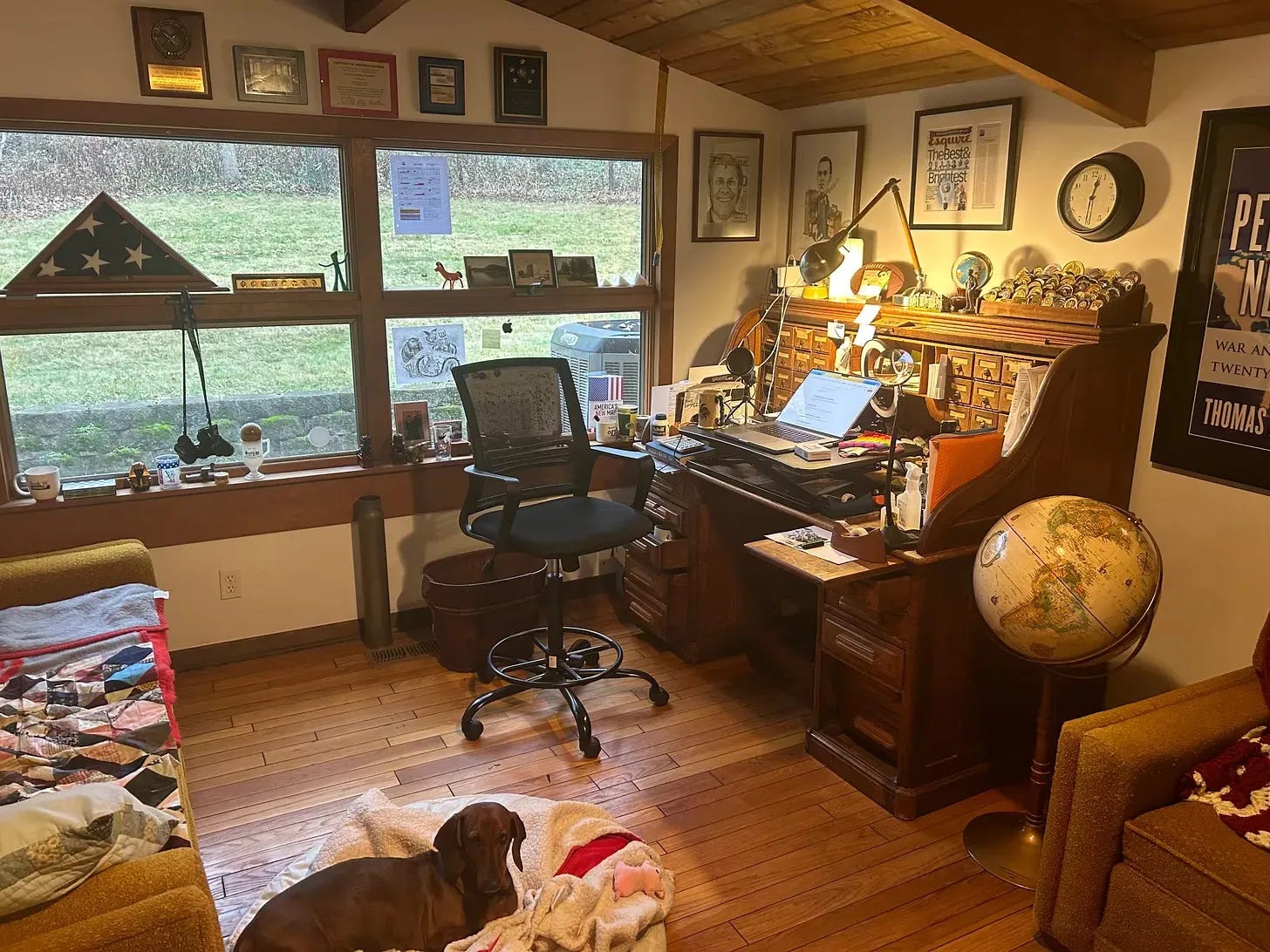
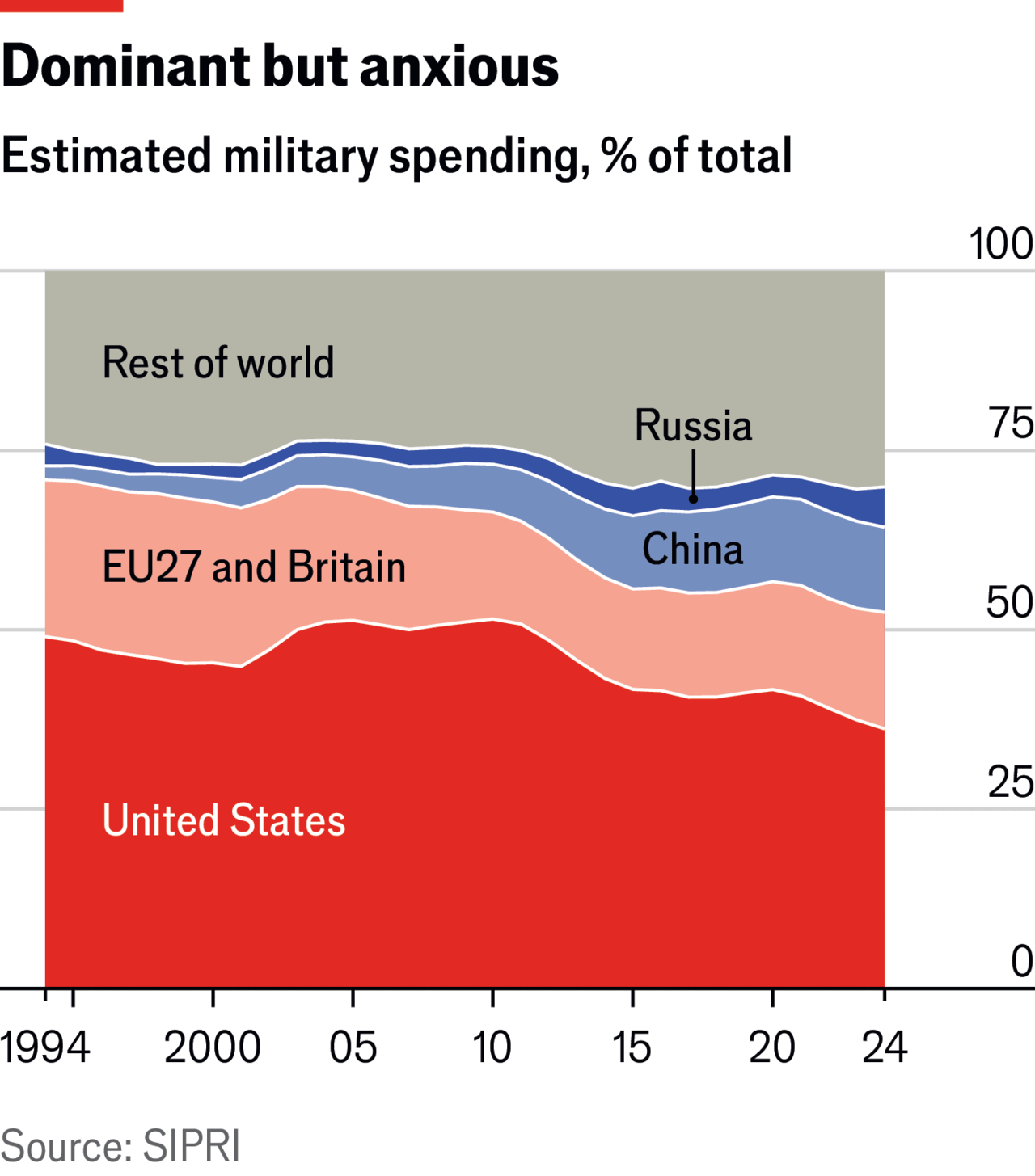


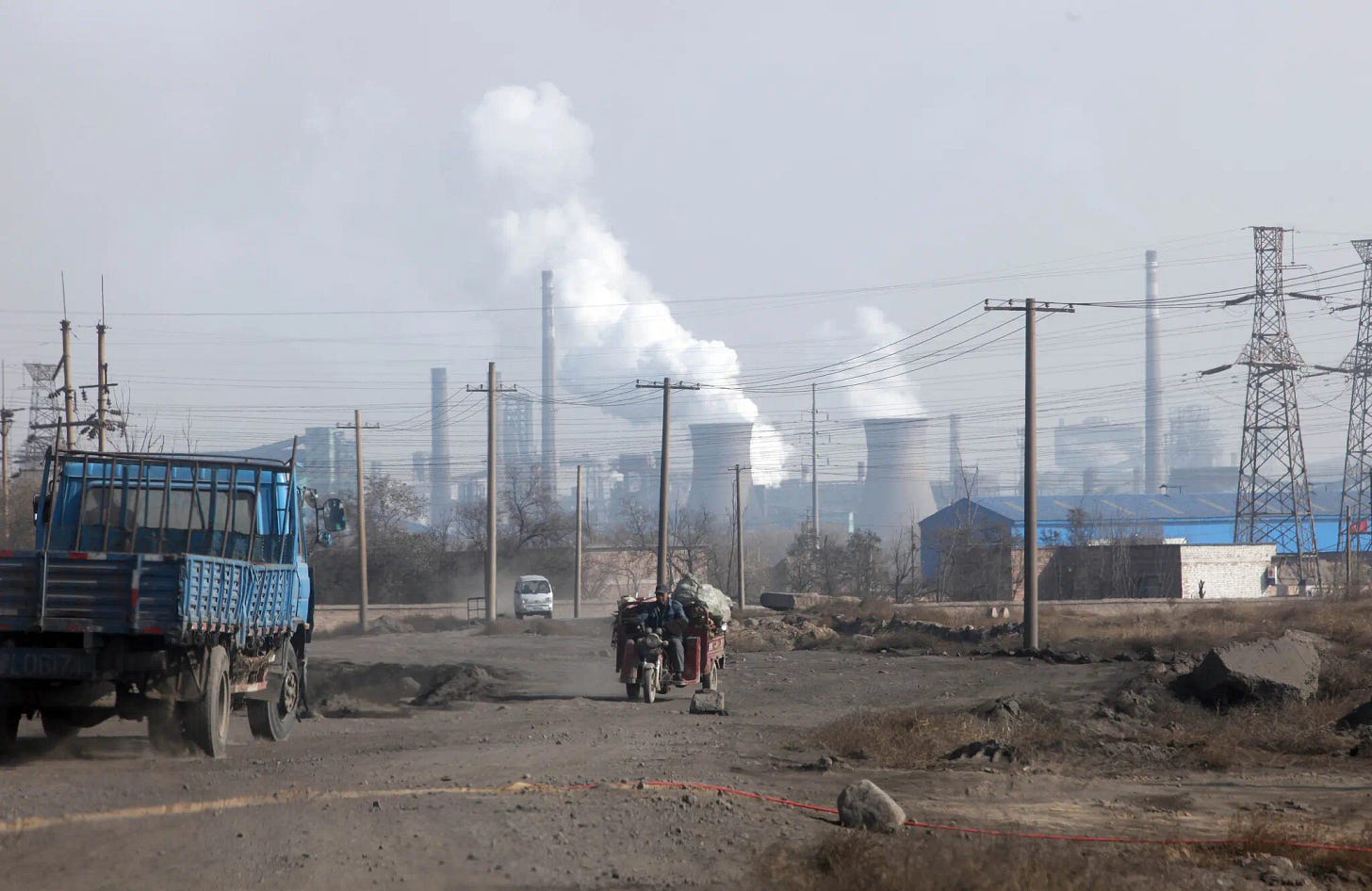
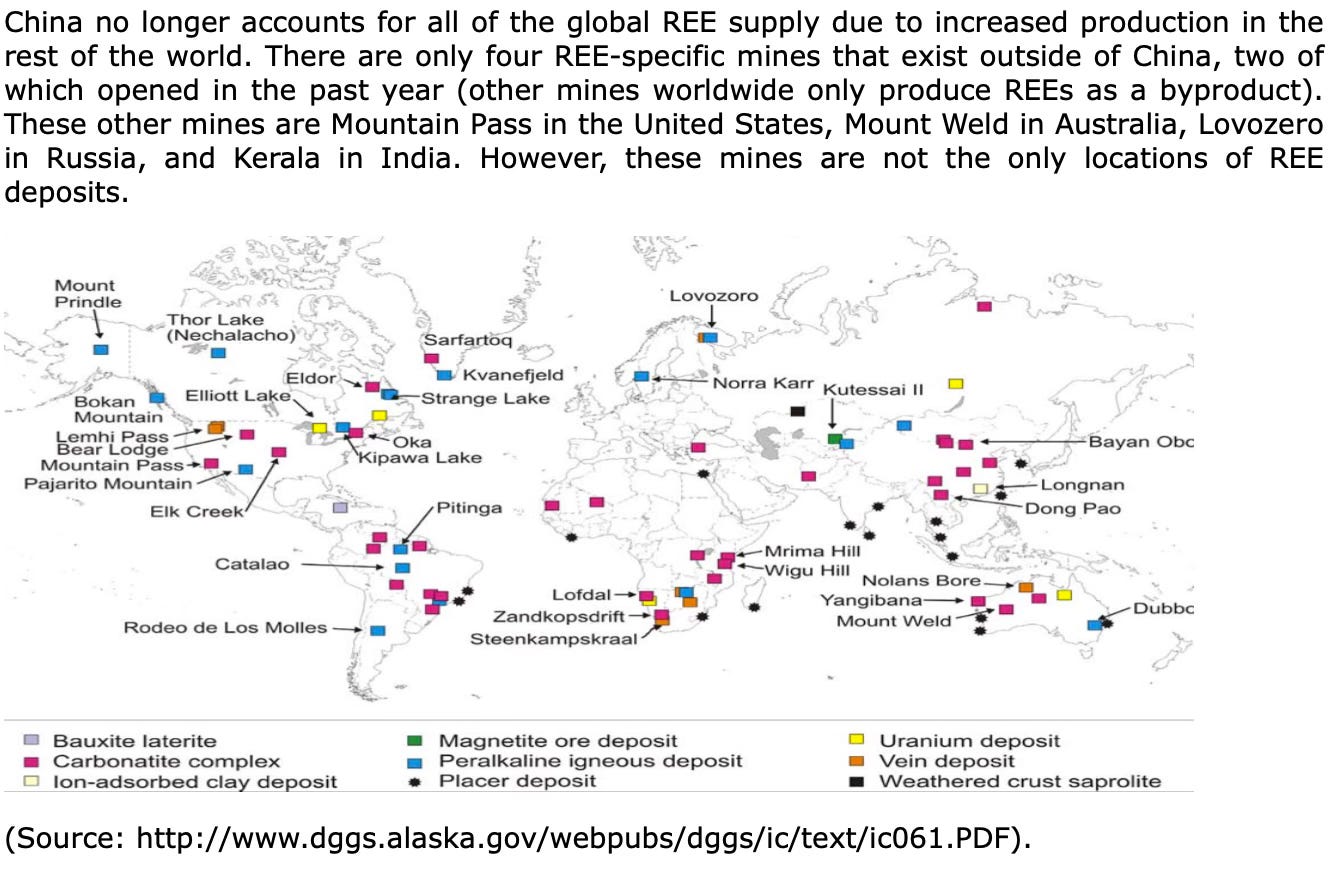






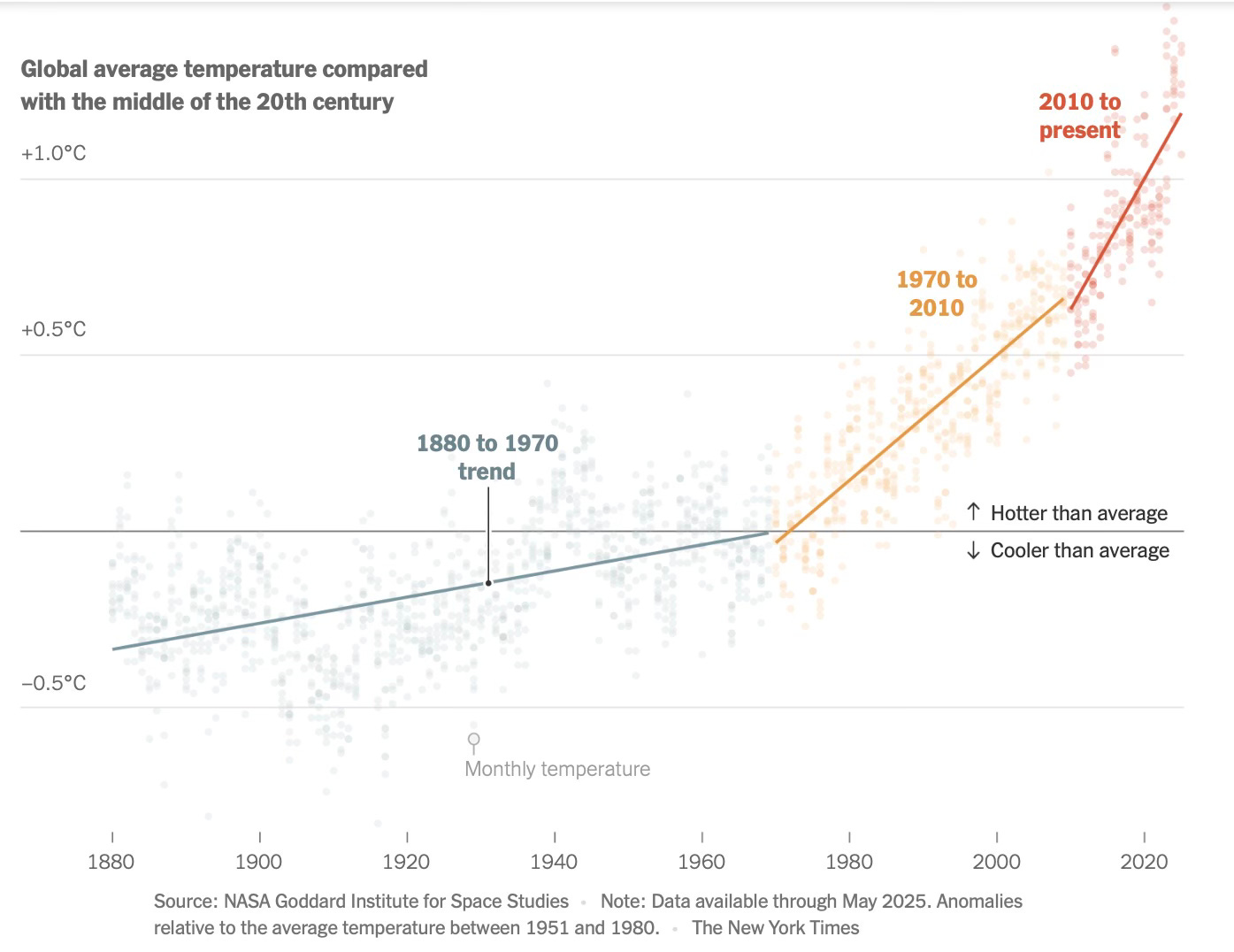


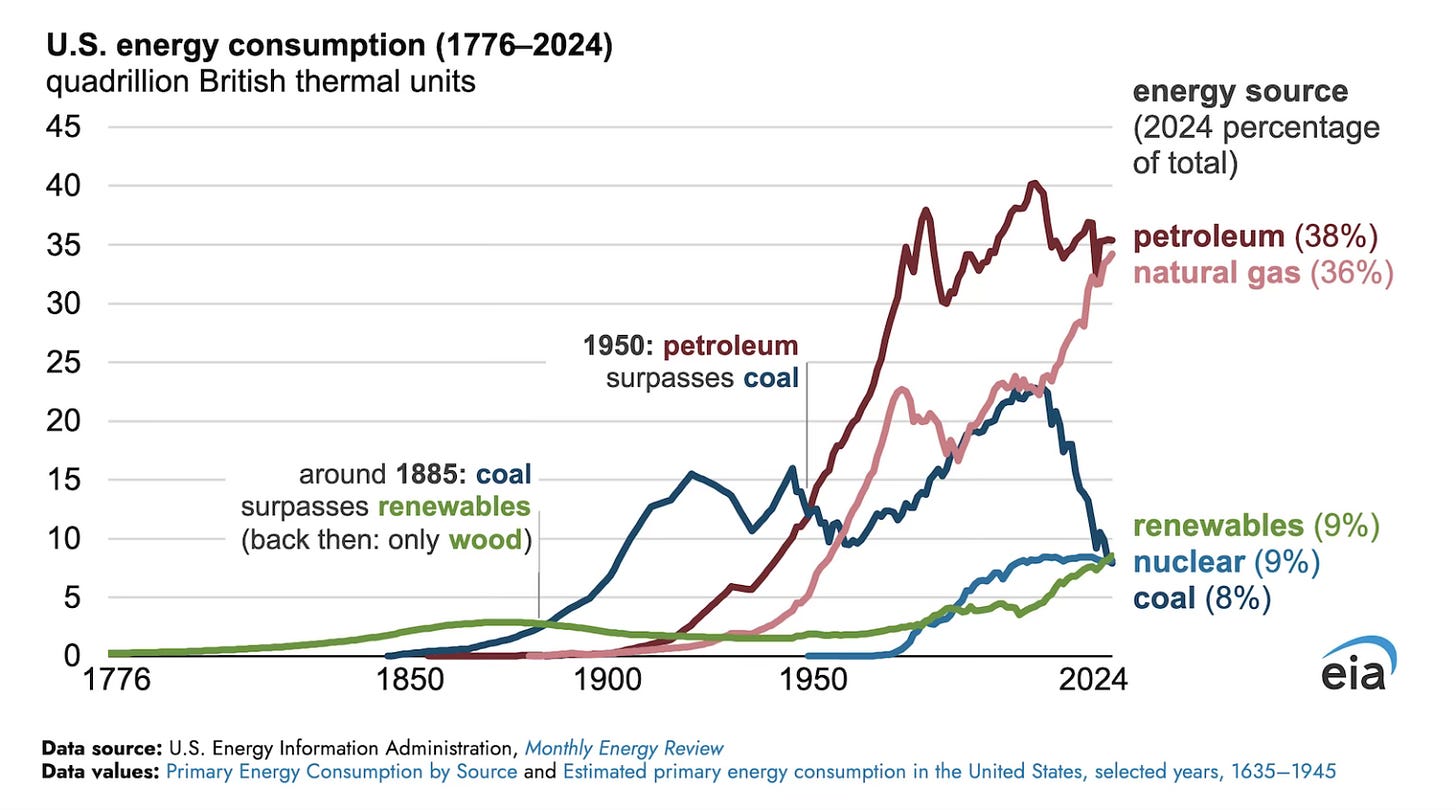
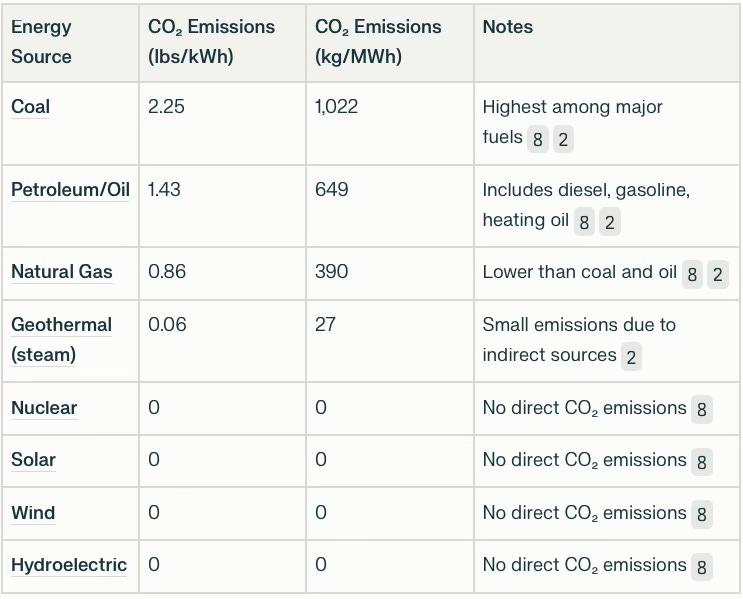
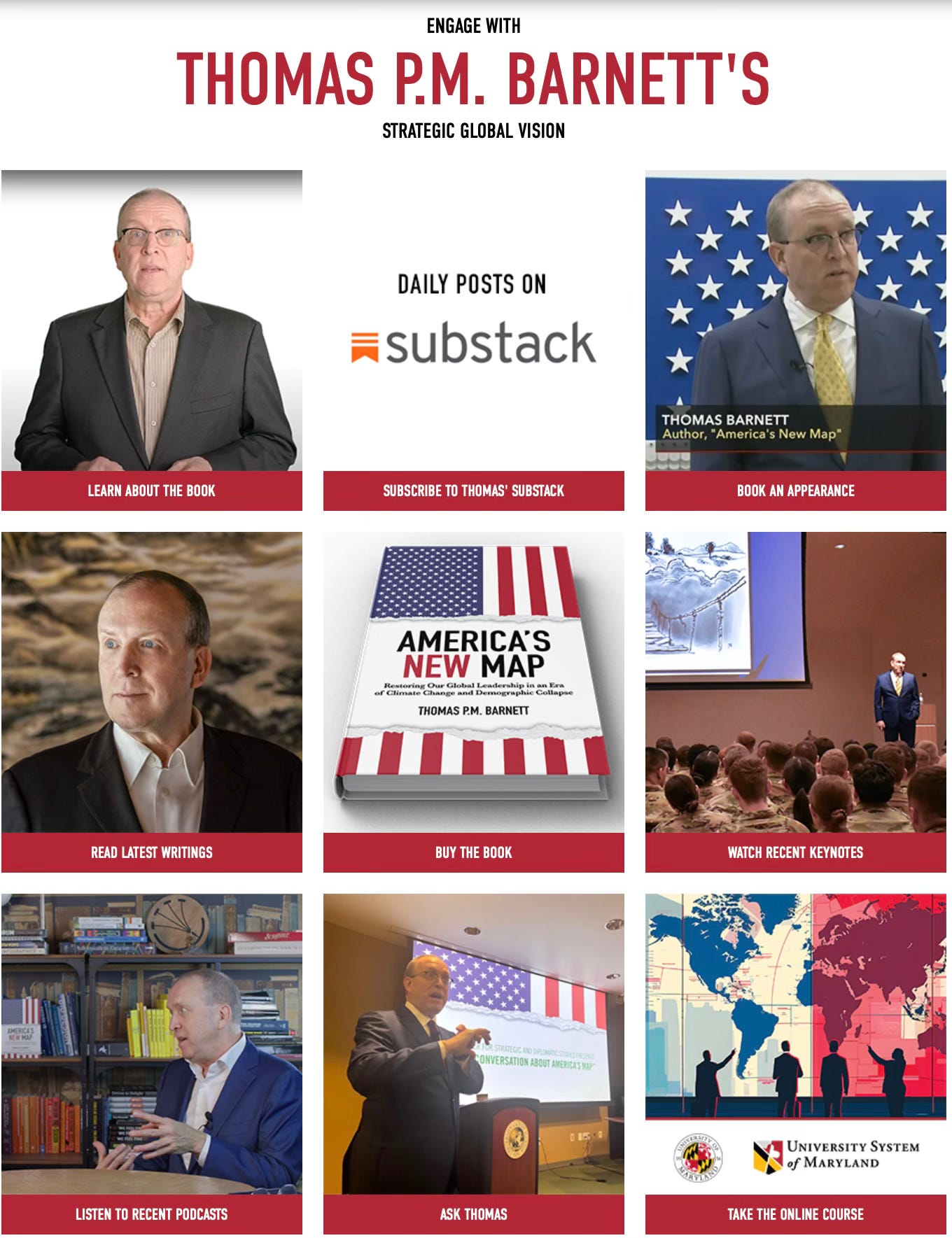

While it's nice to see the 0's at the bottom of the table, I wonder about the massive amount of concrete in a nuclear plant, all the Diesel involved in mining, transporting and remediating the Uranium. Is all that so small to round off to zero?